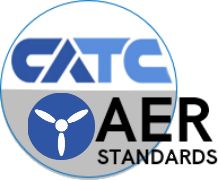BPS CTE Aviation Standards Book
Completion requirements
Standards
 AER-HS.1 Standard 1 - Basics and Control Systems
AER-HS.1 Standard 1 - Basics and Control Systems
Topic 1_1 Aircraft Basics
- AER-HS.1_1.01 Identify the components of different types of aircraft, both exterior and interior.
- AER-HS.1_1.02 Compare and contrast categories and classes of aircraft: airplane, rotorcraft, glider, powered-lift, and lighter-than-air.
- AER-HS.1_1.03 Compare and contrast the various categories into which aircraft are organized during certification: normal, experimental, restricted, acrobatic, utility, and transport.
Topic 1_2 Aircraft Flight Instruments
- AER-HS.1_2.01 Identify the seven basic/standard instruments.
- AER-HS.1_2.02 Describe the operation/limitations of the pitot-static system.
- AER-HS.1_2.03 Describe the operation/limitations of the gyroscopic system.
- AER-HS.1_2.04 Describe the operation/limitations of the magnetic system.
- AER-HS.1_2.05 Describe how instruments will function when the pitot-static system is blocked.
- AER-HS.1_2.06 Explain how the principles of gyroscopic procession and rigidity in space affect the gyroscopic instruments.
- AER-HS.1_2.07 Explain how to cope with magnetic compass errors.
Topic 1_3 Flight Systems
- AER-HS.1_3.01 Explain the function of the battery, alternator, and magneto.
- AER-HS.1_3.02 Discuss fuel systems.
- AER-HS.1_3.03 Explain the cycle of an internal combustion engine.
- AER-HS.1_3.04 Describe common errors with the induction system.
- AER-HS.1_3.05 Compare differences between fixed pitch and constant speed propellers.
- AER-HS.1_3.06 Explain the operation and limitations of the flight control system (primary and secondary).
- AER-HS.1_3.07 Explain the operation and limitations of the powerplant.
- AER-HS.1_3.08 Explain the operation and limitations of the gear system.
- AER-HS.1_3.09 Explain the operation and limitations of the environmental system.
Topic 1_4 Aircraft Construction
- AER-HS.1_4.01 Construct a model aircraft.
- AER-HS.1_4.02 Interpret plans/instructions for homebuilt aircraft.
- AER-HS.1_4.03 Identify techniques used for homebuilt aircraft.
- AER-HS.1_4.04 Assemble/re-assemble a full-scale aircraft part (e.g., fuselage, empennage, wing)
 AER-HS.2 Standard 2 - Science of Flight
AER-HS.2 Standard 2 - Science of Flight
Topic 2_1 Aerodynamics of Flight
- AER-HS.2_1.01 Describe and explain the relationship the four forces of flight.
- AER-HS.2_1.02 Define the angle of attack and critical angle of attack.
- AER-HS.2_1.03 Describe the types of drag, both parasite and induced.
- AER-HS.2_1.04 Explain various wing shapes and how wing tip vortices are created.
- AER-HS.2_1.05 Discuss and compare the four main types of wing flaps and the advantages and disadvantages to their uses.
- AER-HS.2_1.06 Explain how Newton’s Third Law and Bernoulli’s principle affect lift.
- AER-HS.2_1.07 Identify the parts of an airfoil (e.g., chord line, relative wind, camber, leading edge, trailing edge).
- AER-HS.2_1.08 Describe the aerodynamics of a stall.
- AER-HS.2_1.09 Define static and dynamic stability.
- AER-HS.2_1.10 Discuss the aerodynamics of a spin.
- AER-HS.2_1.11 Describe the hazards of wake turbulence.
- AER-HS.2_1.12 Explain ground effect.
Topic 2_2 Weather Theory
- AER-HS.2_2.01 Identify the gases and ratios found within the atmosphere.
- AER-HS.2_2.02 Describe factors that affect atmospheric weather patterns.
- AER-HS.2_2.03 Identify and explain the various family of clouds.
- AER-HS.2_2.04 Explain the formation of clouds and the conditions necessary to form each type.
- AER-HS.2_2.05 Explain and compare the various types of precipitation.
- AER-HS.2_2.06 Explain the importance of atmospheric stability and cloud formation.
- AER-HS.2_2.07 Compare dew point and humidity.
- AER-HS.2_2.08 Identify the various stages of thunderstorms and the hazards to flight.
- AER-HS.2_2.09 Describe conditions that would be necessary for fog formation
Topic 2_3 Weather Products and Reports
- AER-HS.2_3.01 Identify Terminal Aerodrome Forecast (TAF) codes (e.g., TEMPO, FM).
- AER-HS.2_3.02 Explain, analyze, and apply TAFs.
- AER-HS.2_3.03 Explain the importance of a winds aloft forecast.
- AER-HS.2_3.04 Identify abbreviations (e.g., RA, BR, and SN) used in METAR weather reports.
- AER-HS.2_3.05 Decode, analyze, and apply METARs.
- AER-HS.2_3.06 Analyze weather graphics.
- AER-HS.2_3.07 Determine weather products issuance and valid times.
- AER-HS.2_3.08 Describe how to obtain official weather briefings and FAA approved sources or products.
- AER-HS.2_3.09 Predict weather conditions in an area based on available data.
- AER-HS.2_3.10 Interpret current atmospheric conditions at an airport.
Topic 2_4 Weight and Balance
- AER-HS.2_4.01 Define weight and balance terms (e.g., center of gravity, basic empty, weight and useful load).
- AER-HS.2_4.02 Identify the methods of calculating weight and balance.
- AER-HS.2_4.03 Explain the effects of weight on aircraft performance.
- AER-HS.2_4.04 Explain the effects of forward/aft center of gravity on aircraft performance.
- AER-HS.2_4.05 Determine the center of gravity using the computation method.
Topic 2_5 E6B Flight Computer
- AER-HS.2_5.01 Calculate Time/Distance/Rate problems.
- AER-HS.2_5.02 Compute groundspeed and wind correction angle.
- AER-HS.2_5.03 Demonstrate accurate multi-step calculations using a flight computer.
Topic 2_6 Performance Calculations
- AER-HS.2_6.01 Determine aircraft performance problems.
- AER-HS.2_6.02 Determine aircraft performance predictions using current aircraft information and atmospheric conditions.
- AER-HS.2_6.03 Compare predicted aircraft performance vs. actual aircraft performance (actual or simulated).
- AER-HS.2_6.04 Determine predicted aircraft performance changes if a modification to airframe or powerplant occurs.
 AER-HS.3 Standard 3 - Ground and Inflight Operations
AER-HS.3 Standard 3 - Ground and Inflight Operations
Topic 3_1 Airport Operations
- AER-HS.3_1.01 Discuss and explain each leg of standard and nonstandard traffic patterns.
- AER-HS.3_1.02 Describe how runway numbers are determined.
- AER-HS.3_1.03 Recognize various types of airports (controlled and uncontrolled).
- AER-HS.3_1.04 Explain the purpose of a displaced threshold.
- AER-HS.3_1.05 Explain the purpose of a blast pad.
- AER-HS.3_1.06 Recognize visual aids and their purpose (e.g., signs, lights, and markings).
- AER-HS.3_1.07 Create an airport diagram using appropriate signs, lights, and markings.
- AER-HS.3_1.08 Demonstrate a standard traffic pattern using the simulator.
Topic 3_2 Airspace
- AER-HS.3_2.01 Compare the classes of controlled and uncontrolled airspaces and airports.
- AER-HS.3_2.02 Identify the airspace dimensions needed for each class of airspace.
- AER-HS.3_2.03 Recognize various classes of airspace on sectional charts.
- AER-HS.3_2.04 Identify the minimum weather requirements for each class of airspace.
- AER-HS.3_2.05 Categorize the pilot qualifications needed for each class of airspace.
- AER-HS.3_2.06 Explain the aircraft requirements for each class of airspace.
- AER-HS.3_2.07 Determine when it would be necessary to request a special VFR clearance.
- AER-HS.3_2.08 Identify airspace at a given location using a sectional chart.
- AER-HS.3_2.09 Determine special use airspace on a sectional chart.
Topic 3_3 Flight Communication
- AER-HS.3_3.01 Demonstrate use of the phonetic alphabet and numbers.
- AER-HS.3_3.02 Convert local times to Zulu time and vice versa.
- AER-HS.3_3.03 Discuss the purpose of the following facilities/frequencies: ground control, tower, CTAF, Unicom, FSS, approach/departure control, ATIS and enroute center.
- AER-HS.3_3.04 Describe the purpose of an airplane’s transponder.
- AER-HS.3_3.05 Explain the standard and emergency squawk codes.
- AER-HS.3_3.06 Explain light gun signals and their purpose.
- AER-HS.3_3.07 Demonstrate flight in a simulated tower environment.
- AER-HS.3_3.08 Explain proper communication procedures in an emergency situation.
- AER-HS.3_3.09 Describe lost communications procedures.
Topic 3_4 Navigation
- AER-HS.3_4.01 Identify pilotage and dead reckoning techniques.
- AER-HS.3_4.02 Explain when radio navigation would be beneficial.
- AER-HS.3_4.03 Plan a flight using VOR navigation techniques.
- AER-HS.3_4.04 Plan a flight using GPS navigation techniques.
- AER-HS.3_4.05 Demonstrate appropriate radio navigation techniques using VOR and GPS.
- AER-HS.3_4.06 Determine the most appropriate radio navigation technique for a flight.
Topic 3_5 Cross Country Flight Planning
- AER-HS.3_5.01 Demonstrate use of flight planning tools (e.g., AFD, E6B, and Plotter Sectional charts).
- AER-HS.3_5.02 Plan a XC flight using multiple navigation techniques.
- AER-HS.3_5.03 Complete nav-log for preflight planning.
- AER-HS.3_5.04 Demonstrate a XC flight using a flight simulator.
 AER-HS.4 Standard 4 - People, Trends, and Careers in Aviation
AER-HS.4 Standard 4 - People, Trends, and Careers in Aviation
Topic 4_1 Events and Trends in Aviation
- AER-HS.4_1.01 Discuss important people in aviation history and their contribution to the field of aviation.
- AER-HS.4_1.02 Determine the progression of aviation technology (e.g., Pre-Heavier than air flight, gliders (pre-Wright brothers), World War I and II, the jet age, and NextGen aviation).
- AER-HS.4_1.03 Identify and explain current issues (including socio-economic challenges) in aviation.
- AER-HS.4_1.04 Describe how events in aviation history are changing the future of aviation.
Topic 4_2 Aviation Training Requirements
- AER-HS.4_2.01 Describe flight training processes.
- AER-HS.4_2.02 Determine the period of time for medical certificate validity.
- AER-HS.4_2.03 Identify the mission of aviation organizations (e.g., AOPA, EAA, CAP).
- AER-HS.4_2.04 Determine FAA Pilot certificate requirements.
Topic 4_3 Aviation Physiology
- AER-HS.4_3.01 Explain the PAVE checklist.
- AER-HS.4_3.02 Discuss the IMSAFE checklist.
- AER-HS.4_3.03 Describe the medical qualifications requirements for pilots.
- AER-HS.4_3.04 Identify and explain the various parts of the vestibular system, how the kinesthetic sense affects humans, and the function of the human eye.
- AER-HS.4_3.05 Identify each type of hypoxia and associated causes.
- AER-HS.4_3.06 Describe symptoms of hypoxia.
- AER-HS.4_3.07 Describe corrective actions for hypoxia.
- AER-HS.4_3.08 Explain the development of night vision.
- AER-HS.4_3.09 Discuss the importance of spatial awareness and disorientation.
- AER-HS.4_3.10 Describe the effect on pilot performance time at various altitudes.
Topic 4_4 Aviation Careers
- AER-HS.4_4.01 Identify career opportunities in aviation.
- AER-HS.4_4.02 Identify current career trends in aviation.
- AER-HS.4_4.03 Discuss pathways to an aviation career.
- AER-HS.4_4.04 Create an educational plan to pursue an aviation career.
 AER-HS.5 Standard 5 - Unmanned Aircraft Systems
AER-HS.5 Standard 5 - Unmanned Aircraft Systems
Topic 5_1 Basic understanding of statute
- AER-HS.5_1.01 Demonstrate understanding of the applicability and definitions of 14 CFR part 107 to unmanned aircraft operations.
- AER-HS.5_1.02 Understand how to report accidents and demonstrate compliance to code.
Topic 5_2 Operating Rules
- AER-HS.5_2.01 Identify the responsibility and authority of the remote PIC.
- AER-HS.5_2.02 Discuss rules of UAS operation under hazardous conditions.
- AER-HS.5_2.03 Explain the definitions of daylight operation and visual line of sight (VLOS).
- AER-HS.5_2.04 Determine the authorized and prohibited usages of an sUAS (ex. Multiple sUAS, hazardous material, operations over human beings, etc.).
- AER-HS.5_2.05 Understand the importance of rules governing flight path, general airspace considerations, and reporting.
- AER-HS.5_2.06 Demonstrate the operating limitations for sUAS, including maximum groundspeed, altitude, visibility, and cloud clearance).
Topic 5_3 Airspace Classification
- AER-HS.5_3.01 Understand the significance of airspace Class B, C, D, E, and G as they pertain to UAS.
- AER-HS.5_3.02 Identify special-use airspace where UAS usage may be prohibited.
- AER-HS.5_3.03 Demonstrate knowledge of other airspace areas and entities (MTRs, TFRs, Parachute Jump Operations, NSU, VFR routes, Air Traffic Control, and operations near airports).
- AER-HS.5_3.04 Identify potential flight hazards associated with airspace (including smoke, precipitation, wires, emergency aircraft, and structures).
Topic 5_4 Sources of Weather
- AER-HS.5_4.01 Demonstrate correct usage of internet weather briefings and sources of weather for UAS flight planning purposes.
- AER-HS.5_4.02 Understand METAR weather reports, terminal aerodrome forecasts (TAF), automated surface observing systems (ASOS), and automated weather observing systems (AWOS) as they apply to UAS.
- AER-HS.5_4.03 Identify weather factors and their effects on performance of an sUAS (ex. Density altitude, wind, currents, air masses, icing, fog, lightning, thunderstorms, ceiling, etc.).
Topic 5_5 Loading and Performance
- AER-HS.5_5.01 Demonstrate understanding of general loading and performance with effects of loading changes and balance, stability, and center of gravity.
- AER-HS.5_5.02 Identify the importance and use of performance data to calculate the effect.
Topic 5_6 Operations
- AER-HS.5_6.01 Demonstrate understanding of airport operations with and without an operating control tower.
- AER-HS.5_6.02 Describe and use Common Traffic Advisory Frequency (CTAF).
- AER-HS.5_6.03 Demonstrate self-announcing of position of intentions, aircraft call signs, registration numbers, the phonetic alphabet, and phraseology.
- AER-HS.5_6.04 Identify types of airports, ATC towers, runway markings, signage, security Identification Display Areas (SIDA), and sources of airport data.
- AER-HS.5_6.05 Demonstrate safety, emergency planning, and proper communication through safe usages and risk management.
- AER-HS.5_6.06 Demonstrate correct Aeronautical Decision-Making (ADM) and Crew Resource Management (CRM).
- AER-HS.5_6.07 Identify and mitigate physiological hazards whiling using an sUAS.
- AER-HS.5_6.08 Understand the importance of basic maintenance and preflight inspection of an sUAS.

